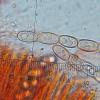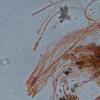
24-12-2025 17:08
Hulda Caroline HolteHello, I have found this propoloid ascomycete on

21-12-2025 09:32
Hello.A tiny ascomycete found embedded in wood in

21-12-2025 21:32
Pol DebaenstHello, Garden, Burgweg 19, Veurne, BelgiumOn 10/1

22-12-2025 23:38
Patrice TANCHAUDBonsoir, récolte sur un mur en pierre, apothéci

22-12-2025 00:47
Patrice TANCHAUDBonsoir, récolte à proximité du milieu dunaire
Anthracobia sp.
Vasileios Kaounas,
22-01-2014 18:48
Asci dimensions 190-215 x 11-14,5 ?m. Ascospores dimensions 12,5-18,5 x 9,5-10,5 ?m. Width paraphyses 7,5-9,5 ?m.
Enrique Rubio,
22-01-2014 18:55
Re : Cheilymenia ???
It's an Anthracobia species, typical of burnt ground
DirkW,
22-01-2014 19:08

Re : Cheilymenia ???
salut vasileios, as enrique said, its anthracobia: a. macrcoystis, a. nitita or a. melanoma. most important are the hairs, which are missing. can you show the hairs too?
best
dirk
best
dirk
Vasileios Kaounas,
22-01-2014 19:17
Re : Cheilymenia ???
Thank you, will look again, because I did not see hairs.
DirkW,
22-01-2014 19:22

Re : Cheilymenia ???
the hairs are very unconspicious! perhaps under 80 and very pale.
Vasileios Kaounas,
23-01-2014 10:33
Re : Anthracobia sp.
I tried, but I did not see hairs.....
Vasileios Kaounas,
28-02-2014 15:56
Re : Anthracobia sp.
I found it again in the same place, i put Melzer and the asci were not amyloidi, but maybe made the paraphyses ? Hair again I dont saw.
Enrique Rubio,
28-02-2014 16:57
Re : Anthracobia sp.
The inconspicuous roundish hairs belong to Anthracobia macrocystis or A. nitida, but I don't know well the differences between these two species. The greenish reaction of the paraphyses in iodine are typical for their content in carotenoid pigments.
Vasileios Kaounas,
28-02-2014 17:21
Re : Anthracobia sp.
Thanks Enrique.
macrocystis = Asci cylindrical, 165-190 x 11-15 ?m, 8-spored, operculate, not bluing in iodine. Asco-spores uniseriate, smooth, biguttulate, elliptical to narrowly ellipti¬cal, (16)17-20 x 7.5-9.0 ?m,
nitida = Asci cylindrical, 170-210 x 9-12 ?m, 8-spored, operculate, not bluing in iodine. Ascospores uniseriate, uninucleate, smooth, biguttulate, elliptical, 16-19 x (6)7-9 ?m
http://ir.library.oregonstate.edu/xmlui/bitstream/handle/1957/44151/LarsenHarold1976.pdf?sequence=3
not helped these differences !!!
macrocystis = Asci cylindrical, 165-190 x 11-15 ?m, 8-spored, operculate, not bluing in iodine. Asco-spores uniseriate, smooth, biguttulate, elliptical to narrowly ellipti¬cal, (16)17-20 x 7.5-9.0 ?m,
nitida = Asci cylindrical, 170-210 x 9-12 ?m, 8-spored, operculate, not bluing in iodine. Ascospores uniseriate, uninucleate, smooth, biguttulate, elliptical, 16-19 x (6)7-9 ?m
http://ir.library.oregonstate.edu/xmlui/bitstream/handle/1957/44151/LarsenHarold1976.pdf?sequence=3
not helped these differences !!!
Stephen Martin Mifsud,
17-01-2017 06:49

Re : Anthracobia sp.
I found three populations of Anthracobia nitida but one of the populations had smaller spores then reported: 14-16um long, more or less the same as reported by Vasileios Kaounas ( the poster of this post) from Greece. I guess it still qualifies as A. nitida.
In the work of Larsen Harold (1976) this population would classify as Anthrocobia taxonomic species A if you follow the keys on page 42-44/92 (and gosh - that thesie was produced with a type-writer!)
Myself, I have problems to distinguish (from literature) nitida and macrocystis (just tiny differences in hair length and spores, which intersect anyway), but I think I have spotted a third difference (from Larsen Harold descriptions of both spp.) where A. nitida has a more pronounced brown-spotted clothing on the lower surface of the excipulum from that of A. macrocystis (where from the description they are lighter or restricted to the margin). See my image below
What do you think please?
In the work of Larsen Harold (1976) this population would classify as Anthrocobia taxonomic species A if you follow the keys on page 42-44/92 (and gosh - that thesie was produced with a type-writer!)
Myself, I have problems to distinguish (from literature) nitida and macrocystis (just tiny differences in hair length and spores, which intersect anyway), but I think I have spotted a third difference (from Larsen Harold descriptions of both spp.) where A. nitida has a more pronounced brown-spotted clothing on the lower surface of the excipulum from that of A. macrocystis (where from the description they are lighter or restricted to the margin). See my image below
What do you think please?
 chelymenia-0001.pdf
chelymenia-0001.pdf

